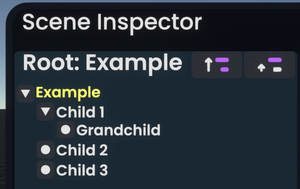Chaque objet dans Resonite est un Slot. Les slots forment des hiérarchies, existent dans un espace 3D via des transformations et contiennent des Composants qui ajoutent des comportements.
Propriétés basiques
Hiérarchie

Un slot peut contenir un ou plusieurs slots formant une hiérarchie ou arborescence. Un slot est un enfant si il est contenu dans un autre slot; cet slot est dit parent. Le seul slot sans parent est le root (ou racine) du monde, qui contiens tous les autres slots.
Cette hiérarchie est utilisée pour organiser, transformer (voir ci dessous) et pour bien d'autres fonctionnalités de Resonite.
Transformation
Every slot can be transformed in 3D space: it can be translated (moved), rotated, and scaled. A child slot's transformation is relative to its parent, so even though a child slot might specify no transformation, in global space it may be rotated or scaled because its parents are. Thus, a child's transform is called "local".
Components
Main article: Component
Slots contain components, which provide almost all the functionality in Resonite. See the main article for details.
Fields
Similar to Components, slots have a number of fields that can be modified:
| Name | Type | Description |
|---|---|---|
Name
|
String | Parent |
Slot
|
Tag | String |
Active
|
Bool | Persistent |
Bool
|
Position | Float3 |
Rotation
|
FloatQ | Scale |
Float3
|
OrderOffset | Long |
Working With Slots
With the Scene Inspector
As a user, slots are primarily manipulated through the Scene Inspector. You can view, create, destroy and modify slots and their components.
With ProtoFlux
ProtoFlux has a set of nodes for working with the slot hierarchy, see Category:ProtoFlux:Slots for a list. Note that access to a slot's components is currently limited.[1]